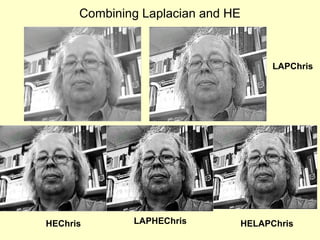Digital Image Processing_ ch2 enhancement spatial-domain
- 1. Chapter 2 Im Enhancem in age ent the Spatial Dom ain:
- 2. Image Enhancement – Aims & Objectives Image enhancement aims to process an image so that the output image is “more suitable” than the original. Suitability may be subjective but it is application-dependent. It includes sharpening, smoothing, highlighting features, or normalising illumination for display and/or analysis. Either helps solve some computer imaging problems, or is used as an end in itself to improve “image quality”. Enhancement methods are either used as a preprocessing step to other imaging tasks, or as post-processing to create a more visually desirable image.
- 3. Image Enhancement – General Approach Image processing techniques are based on performing Image transformations using Image operators that either manipulate the spatial information (i.e. pixel values) or the frequency information (the light wave components). The easiest type of Image operators are Linear. An image operator ζ is said to be linear if for any two images f and g, and two numbers a and b: ζ(af+bg) = a ζ(f) + b ζ(g).
- 4. Image Enhancement – General Approach Enhancing an image in the spatial domain could be achieved by image operators that transform an image by changing pixel values or move them around. Selecting the most appropriate image enhancing operators often require an analysis of the image content and depends on the aim of enhancement. Automatically triggered enhancement is desirable but may be difficult. In some cases it is a trial & error process. Success of enhancement may be evaluated subjectively by viewers or according to defined criterion.
- 5. Image Histogram The frequency distribution of gray values in an image conveys useful information on image content and may help determine the nature of the required enhancement For any image f of size mxn and Gray Level resolution k, the histogram of h is a discrete function defined on the set {0, 1, …, 2k-1} of gray values such that h(i) is the number of pixels in the image f which have the gray value i. It is customary to “normalise” a histogram by dividing h(i) by the total number of pixels in the image, i.e. use the probability distribution: p(i) = h(i)/mn. Histograms are used in numerous processing operations.
- 7. Local Vs Global Histograms – Image Features • Histograms for parts of an image provide information on illumination and distortion and are thus useful for feature analysis. • Local Histograms may provide more information on image content than the global histogram.
- 8. Histograms of an image in different Colour Channels Some Facial features are detected using specific colour channels
- 9. Image Operators in the Spatial domain • An image operator in the spatial domain T applied on an image f(x,y) defines an output image: g(x,y) = T(f(x,y)) which is defined in terms of the pixel values in a neighbourhood centred at (x,y). • Most commonly used neighbourhoods are squares or rectangles. • The simplest form of T is when the neighbourhood consists of the pixel itself alone, i.e it depends on f(x,y) alone. In this case, T is a Gray Level transform which maps the set {0,1, …,L-1} of grey levels into itself, i.e. is a function: T: {0,1,…,L-1} → {0,1, …, L-1}. • Larger size neighbourhood-based operators are referred to as mask processing or filtering.
- 10. Simple Gray Level transforms The most common type of grey level transforms are linear or piecewise (not necessarily continuous) linear functions The Image Negative transform an image with gray level in the range {0,1,…,L-1} using the negative map: TNeg (i) = L - 1 – i. e.g. if L = 2 = 256 then 8 Negative Im age Transform 255 204 153 102 51 0 0 TNeg(i) = 255 – i. 51 102 153 204 255
- 11. Example – Negative of an image The negative image is a useful tool in analysing Digital Mammograms.
- 12. Piecewise Linear Gray Level transforms • For any 0 < t < 255 the threshold transform Thrt Thresholding Transform s 255 204 is defined for each i by: 0 Thrt (i) = 153 If i < t 102 51 i otherwise 0 0 Thr80 51 102 153 204 255
- 13. The Threshold Transform in VC.Net
- 14. A Piecewise Linear Gray Level transform This chart represents the transform T which is defined for each i by: Peicewise_linear 255 240 225 210 195 180 165 150 135 120 105 90 75 60 45 30 15 0 If i ≤ 110 2*i T (i) = If 110 <i ≤ 200 i 255 0 15 30 45 60 75 90 105 120 135 150 165 180 195 210 225 240 255 T If i >200.
- 15. The above Piecewise Transform in MATLAB
- 16. Non-linear Basic Gray Level transforms • The Log transform is based on a function of the form: Logc (i) = = c Log(1+ i) for a constant c. Depending the value of c, this function darken the pixels in a non-uniform way. Log(1+i) 10 9 8 7 6 5 4 3 2 1 0 -20 35 90 145 200 255 Gamm(i,0.7) • The Gamma transform is based on a function of the form: Gamma(c, γ) (i) = c *i 60 50 40 γ for constants c and γ. The effect of this transform depends on the value of c and γ. 30 20 10 0 -45 5 55 105 155 205 These transforms effect different images in different ways. 255
- 19. Why power laws are popular? • A cathode ray tube (CRT), for example, converts a video signal to light in a nonlinear way. The light intensity I is proportional to a power (γ) of the source voltage VS • For a computer CRT, γ is about 2.2 • Viewing images properly on monitors requires γ-correction
- 20. Effect of Gamma transform –Examples γ >1 Original Aerial image Gamma transform, c =1, γ =4.0 Gamma transform, c =1, γ =3.0 Gamma transform, c =1, γ =5.0
- 21. Effect of Gamma transform - Examples γ <1 Original MRI image Gamma transform, c =1, γ =0.6 Gamma transform, c =1, γ =0.4 • From the two examples, we note that: dark areas become brighter and very bright areas become slightly darker. • Faint images can be improved with γ >1, and dark images benefit from using γ <1.
- 22. Contrast & Brightness concepts The dynamic range of an image is the exact subset of grey values {0,1,…,L-1} that are present in the image. The image histogram gives a clear indication on its dynamic range When the dynamic range contains significant proportion of the grey scale, then the image is said to have a high dynamic range, and the image will have a high contrast. Low–contrast images can result from poor illumination Lack of dynamic range in the imaging sensor Wrong setting of lens aperture at the image capturing stage. The most common enhancing procedures to deal with these problems are Gray Level transform
- 24. Contrast enhansing Gray Level transforms • Contrast Stretching aims to increase the dynamic range of an image. It transforms the gray levels in the range {0,1,…,L-1} by a piecewise linear function. • Gray level Slicing aims to highlight a specific range [A…B] of Gray levels. It simply maps all Gray values in the chosen range to a constant. Other values are either mapped to another constant or left unchanged
- 25. Contrast stretching - Example (227i − 5040) / 47 T (i ) = i if 28 ≤ i ≤ 75 otherwise.
- 26. Gray-level Stretching with Clipping at Both Ends This operator is implemented by the function: 0 255(i - 80)/100 if 80 ≤ i ≤ 180 255 S(i) = if i <80 if i > 180 S Original image Modified image with stretched gray levels
- 27. Gray Level Slicing - Examples
- 28. Effect of Gray Level transforms on Histogram Gray level transforms do change image histograms in ways that depends on the transform equation & parameters The Gray-level stretching shown in diagram 1, below, results in boosting the probability of the gray levels 75 – 255 at the expense of the range 28-75. Diagram 1 The Gray-level slicing shown in diagram 2 results in 0 probability density for all gray levels in the range 150-200 while increasing the probability density of 255. Diagram 2
- 30. Gray-level Stretching with Clipping at Both Ends Original image Histogram Before Image after gray levels stretch Histogram after
- 31. Gray Level Slicing Effects - Examples Original image Histogram Before Image after slicing Histogram after slicing
- 32. Gamma Transform - Example Gamma Transform, c =1, γ =4.0 Original Aerial image Transformed image
- 34. Introduction In the previous slides , we introduced few gray-level transforms that are useful for many image processing tasks such as enhancement, compression and segmentation. Such transforms change input images and their histograms in ways that depend on the transform parameter(s) which are often selected manually. Question: Is it possible to design gray-level transforms that manipulate image histograms in specified ways? Beside answering this we shall study the use of Filtering (i.e. image operators that change pixel values in terms of a subset of a neighboring pixels) for image enhancement.
- 35. Image Histogram & Image brightness Image brightness level can be deduced from Histograms In dark images, histogram components are concentrated on the low (dark) side of the gray scale. In bright images, histogram components are biased toward the high (bright) side of the gray scale.
- 36. Image Histogram & Image contrast Histograms also hold information about image contrast. In low contrast images, histogram components are crammed in a narrow central part of the gray scale. In high contrast images, the histogram occupy the entire gray scale (i.e. Has high dynamic range) in a near uniform distribution.
- 37. Enhancement through Histogram Manipulation • Histogram manipulation aims to determine a graylevel transform that produces an enhanced image that have a histogram with desired properties. • The form of these gray-level transforms depend on the nature of the histogram of the input image and desired histogram. • Desired properties include having a near uniformly distributed histograms or having a histogram that nearly match that of a reference (i.e. template) image. • For simplicity, sometimes we normalise the gray levels r so that 0 ≤ r ≤ 1 rather than being in the set {0,1, …, L-1}.
- 38. One-to-one Functions Definition: A one-to-one (injective) function f from set X to set Y is a function such that each x in X is related to a different y in Y. Y X Y X
- 42. For functions, there are two conditions for a function to be the inverse function: 1) g(f(x)) = x for all x in the domain of f 2) f(g(x)) = x for all x in the domain of g e.g Find the inverse function for f(x) or y = 5x + 2 To find the inverse, interchange x and y. x = 5y + 2 Now isolate for y!! x - 2 = 5y (x - 2)/5 = y or g(x) g(f(x))=((5x + 2) -2)/5=x f(g(x))=5((x - 2)/5 )+2=x
- 43. is Gamma transform reversible? y= cx r y x = c r y r log 2 (x ) = log 2 c 2log 2 (x ) = 2 y log 2 c r y log 2 (x ) = log 2 c y log 2 c log 2 (x ) = r r x=2 y log 2 c r
- 44. is Log transform reversible? y = c log 2 x y log 2 x = c 2 log 2 (x ) x=2 y c =2 y c
- 45. Histogram Equalisation • Due to the randomness of light sources and sensor position among other factors we assume that gray levels in an Image is a random variable with probability density function (pdf) at gray level r being the expected proportion of pixels that have r gray value. r s = T ( r ) = ∫ p ( w) dw. 0 • This works for continuous pdf’s, and for a discrete set {0,1,…,L-1} of gray levels it translates to: r Freq(i ) s = T (r ) = ∑ . N i =o Where Freq(i) is the number of pixels in the image that have Gray value I, and N is the image size
- 46. Pseudo Code for Histogram Equalisation Step 1: Scan the image to calculate the Freq[0..L-1], i.e. histogram Step 2: From the Freq[ ] array compute the cumulative frequency array Cum_freq[0...L-1]: { Cum-freq[0] =Freq[0]; for i=1 to L-1 Cum_freq[i] =Cum_freq[i-1]+Freq[i]; } Step 3: Determine the HE transformation lookup table: for i=0 to L-1 { j= round(Cum_freq[i]*(L-1)/N); T[i] =j; inv_T[j] = i; //optional } Step 4: Transform the image using the lookup table T.
- 47. Example 1 • Histogram is nearer to uniform than original. • Improved Contrast but some added noise.
- 48. Histograms Equalisation – Example 2 Gray levels in the output image are not very uniformly distributed.
- 50. Example 4
- 52. Example 6
- 53. Example 7
- 54. Remarks on HE effects • Histogram Equalisation does improve contrast in some cases, but it may introduce noise and other undesired effect. • Image regions that are dark and not clearly visible become clearer but this may happen at the expense of other regions. • These undesired effect is a consequence of digitization. When digitise the continuous operations rounding leads to approximations. • Images for which different regions exhibit different brightness level, may benefit from applying HE on sub-blocks of the images. • The quality of well lit images after HE suffer more than expected.
- 55. Histogram Matching • The previous examples show that the effect of HE differs from one image to another depending on global and local variation in the brightness and in the dynamic range. • Applying HE in blocks may introduce boundary problems, depending on the block size. • Histogram Matching is another histogram manipulation process which is useful in normalizing light variation in classification problems such as recognition. • HM aims to transform an image so that its histogram nearly matches that of another given image. • HM is the sequential application of a HE transform of the input image followed by the inverse of a HE transform of the given image.
- 56. Pseudo Code for Histogram Matching Step 1: Open the “Inv_HE” a file and read its entries into inv_T0. This file should have been created by the HE++ algorithm for a good template image. Step 2. Scan the input image I to calculate the Freq[0..L-1]. Step 3: From the Freq[] array compute the cumulative frequency array Cum_freq[0...L-1]: { Cum-freq[0] =Freq[0]; for i=1 to L-1 Cum_freq[i] =Cum_freq[i-1]+Freq[i];} Step 4: Determine the HM transformation lookup table: for 0=1 to L-1 j = round(Cum_freq[i]*(L-1)/N); HM_T[i] =Inv_T0[j]; Step 5: Transform the image using the lookup table HM_T.
- 57. Filtering in the spatial domain • Filtering in the spatial domain refers to image operators that transform the gray value at any pixel (x,y) in terms of the pixel values in a square neighbourhood centred at (x,y) using a fixed integer matrix of the same size. • The integer matrix is called a filter, mask, kernel or a window. The operation is mainly the inner product (also known as the convolution) of the pixel neighbourhood subimage with the filter. • The filtering process works by replacing each pixel value with the result of convolution at the pixel. • Filtering is often used to remove noise in images that could occur as a result of less than perfect imaging devices, signal interference, or even as a result of image processing such as HE transforms.
- 58. Spatial Filters - illustration
- 59. Spatial filters classification filters • Spatial filters can be classified by effect: – Smoothing Filters: Aim to remove some small isolated detailed pixels by some form of averaging of the pixels in the masked neighborhood. These are also called lowpass filters. Examples include Weighted Average, Gaussian, and order statistics filters. – Sharpening Filters: aiming at highlighting some features such as edges or boundaries of image objects. Examples include the Laplacian , and Gradient filters. • Spatial filters are also classified in terms of mask size (e.g. 3x3, 5x5, or 7x7).
- 60. A weighted average filter - Example 1 2 1 1 For example, if 2 4 2 and 16 1 2 1 40 45 30 the neighbourhood subimage is 41 50 20 60 70 25 then the pixel value of the output image that corresponds to the central pixel in the neighbourhood is replaced with : (40 + 2 × 45 + 30 + 2 × 41 + 4 × 50 + 2 × 20 + 60 + 2 × 70 + 25) / 16 = int(44.1875) = 44.
- 61. Smoothing filters • Smoothing Filters are particularly useful for blurring and noise reduction. • Smoothing filters work by reducing sharp transition in grey levels. • Noise reduction is accomplished by blurring with linear or non-linear filters (e.g. the order statistics filters). • Beside reducing noise, smoothing filters often remove some significant features and reduce image quality. • Increased filter size result in increased level of blurring and reduced image quality. • Subtracting a blurred version of an image from the original may be used as a sharpening procedure.
- 62. Effect of Averaging Linear Filters original 3x3 filter 9x9 filter 5x5 filter 35x35 filter 15x15 filter The extent of burring increases the larger the filter is.
- 63. Filtering using vc++ Bitmap ^ Filter(Bitmap ^ im1){ Bitmap ^im2=gcnew Bitmap(w,h); int fsize=3; int AvrgFilter[3][3]= {1,2,1,2,4,2,1,2,1} for (x=1;x<w-1 ;x++) for(y=1;y<h-1 ;y++){ int r= 0,g=0,b=0; for ( i=- fsize /2;i<= fsize /2;i++) for ( j=- fsize /2;j<= fsize /2;j++){ Color c=im1->GetPixel(x+i,y+j); r+=c.R* AvrgFilter [i+ fsize /2][j+ fsize /2]; g+=c.G* AvrgFilter [i+ fsize /2][j+ fsize /2]; b+=c.B* AvrgFilter [i+ fsize /2][j+ fsize /2];} r=r/16;g=g/16;b=b/16; im2->SetPixel(x,y,Color::FromArgb(r,g,b));}// for return im2; }
- 64. Order Statistical filters • These refer to non-linear filters whose response is based on ordering the pixels contained in the neighborhood. Examples include Max, Min, Median and Mode filters. • The median which replaces the value at the centre by the median pixel value in the neighbourhood, (i.e. the middle element when they are sorted. • Median filters are particularly useful in removing impulse noise, also known as salt-and-pepper. Noisy image Averaging 3x3 filter Median 3x3 filter
- 65. Example – Effect of different order statistics filters Adding Noise 3x3 median 3x3 max 3x3 min
- 66. Add noise to images
- 67. Sharpening Spatial Filters • Sharpening aims to highlight fine details (e.g. edges) in an image, or enhance detail that has been blurred through errors or imperfect capturing devices. • Image blurring can be achieved using averaging filters, and hence sharpening can be achieved by operators that invert averaging operators. • In mathematics averaging is equivalent to the concept of integration along the gray level range: r s = T ( r ) = ∫ p ( w) dw. 0 Integration inverts differentiation and as before, we need a digitized version of derivatives.
- 68. Derivatives of Digital functions of 2 variables • As we deal with images, which are represented by digital function of two variables, then we use the notion of partial derivatives rather than ordinary derivatives. • The first order partial derivatives of the digital image f(x,y) in the x and in the y directions at (x,y) pixel are: ∂f ∂f = f ( x + 1, y ) − f ( x, y ), and = f ( x, y + 1) − f ( x, y ). ∂x ∂y • The first derivative is 0 along flat segments (i.e. constant gray values) in the specified direction. • It is non-zero at the outset and end of sudden image discontinuities (edges or noise) or along segments of continuing changes (i.e. ramps) .
- 69. 2nd order Derivatives & the Laplacian operator • The first derivative of a digital function f(x,y) is another digital image and thus we can define 2nd derivatives: ∂(∂f ) ∂x = f ( x + 1, y ) + f ( x − 1, y ) − 2 f ( x, y ), and ∂x ∂(∂f ) 2 ∂ f ∂y = = f ( x, y + 1) + f ( x, y − 1) − 2 f ( x, y ). 2 ∂y ∂y ∂ f = 2 ∂x 2 • Other second order partial derivatives can be defined similarly, but we will not use here. • The Laplacian operator of an image f(x,y) is: ∂2 f ∂ 2 f ∇2 f = + 2 . 2 ∂x ∂y
- 70. Digital derivatives –Example ∂f ∂x ∂ f ∂x 2 2 1. ∂f ∂2 f ≠ 0 along the entire ramp, but ≠ 0 at its ends. ∂x 2 ∂f ∂2 f Thus detects thick edges while detects thin edges. ∂x ∂x 2 2. ∂f have stronger response to gray - level step, ∂x ∂2 f but produces a double response at gray - level steps. ∂x 2 ∂x
- 71. The Laplacian Filter • The Laplacian operator, applied to an Image can be implemented by the 3x3 filter: 0 ∇2 ( f ) = 1 0 1 −4 1 0 1. 0 • Image enhancement is the result of applying the difference operator: 0 −1 0 Lap ( f ) = f − ∇2 ( f ) = −1 5 −1. 0 −1 0
- 72. Laplacian filter –Example Original Image Image after Laplacian filer Note the enhanced details after applying the Laplacian filter.
- 74. Combining various enhancement filters • The effect of the various spatial enhancement schemes doesn’t always match the expectation, and depends on input image properties. e.g. histogram equalization introduces some noise. • The application of any operator at any pixel does not depend on the position of the pixel, while the desired effect is often reqired in certain regions. e.g. an averaging filters blurs smooth areas as well as significant feature regions. • Enhancing an image is often a trial & error process. In practice one may have to combine few such operations in an iterative manner . In what follows we try few combined operations.
- 75. Combining Laplacian and HE LAPChris HEChris LAPHEChris HELAPChris
- 76. Combined Laplacian & HE (b) (a) (c) (d) (a) Original, (b) After HE, (c) After Laplacian, (d) HE after Laplacian
- 77. End of Chapter 3
























![Contrast enhansing Gray Level transforms
•
Contrast Stretching aims to
increase the dynamic range
of an image. It transforms
the gray levels in the range
{0,1,…,L-1} by a piecewise
linear function.
•
Gray level Slicing aims to
highlight a specific range
[A…B] of Gray levels. It
simply maps all Gray values
in the chosen range to a
constant. Other values are
either mapped to another
constant or left unchanged](https://image.slidesharecdn.com/dip2-enhancementspatialdomain-131123025619-phpapp01/85/Digital-Image-Processing_-ch2-enhancement-spatial-domain-24-320.jpg)
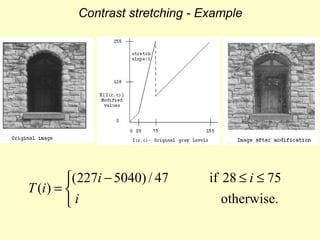
















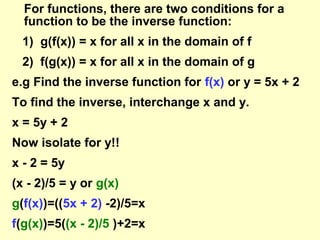



![Pseudo Code for Histogram Equalisation
Step 1: Scan the image to calculate the Freq[0..L-1], i.e. histogram
Step 2: From the Freq[ ] array compute the cumulative frequency
array Cum_freq[0...L-1]:
{ Cum-freq[0] =Freq[0];
for i=1 to L-1
Cum_freq[i] =Cum_freq[i-1]+Freq[i];
}
Step 3: Determine the HE transformation lookup table:
for i=0 to L-1
{ j= round(Cum_freq[i]*(L-1)/N);
T[i] =j;
inv_T[j] = i; //optional
}
Step 4: Transform the image using the lookup table T.](https://image.slidesharecdn.com/dip2-enhancementspatialdomain-131123025619-phpapp01/85/Digital-Image-Processing_-ch2-enhancement-spatial-domain-46-320.jpg)









![Pseudo Code for Histogram Matching
Step 1: Open the “Inv_HE” a file and read its entries into inv_T0.
This file should have been created by the HE++ algorithm
for a good template image.
Step 2. Scan the input image I to calculate the Freq[0..L-1].
Step 3: From the Freq[] array compute the cumulative
frequency array Cum_freq[0...L-1]:
{ Cum-freq[0] =Freq[0];
for i=1 to L-1
Cum_freq[i] =Cum_freq[i-1]+Freq[i];}
Step 4: Determine the HM transformation lookup table:
for 0=1 to L-1
j = round(Cum_freq[i]*(L-1)/N);
HM_T[i] =Inv_T0[j];
Step 5: Transform the image using the lookup table HM_T.](https://image.slidesharecdn.com/dip2-enhancementspatialdomain-131123025619-phpapp01/85/Digital-Image-Processing_-ch2-enhancement-spatial-domain-56-320.jpg)

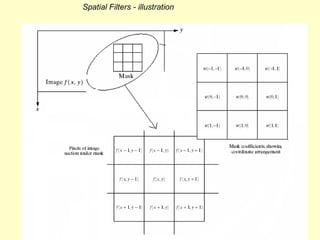



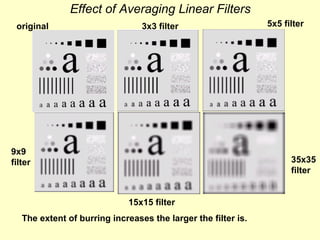
![Filtering using vc++
Bitmap ^ Filter(Bitmap ^ im1){
Bitmap ^im2=gcnew Bitmap(w,h);
int fsize=3;
int AvrgFilter[3][3]= {1,2,1,2,4,2,1,2,1}
for (x=1;x<w-1 ;x++)
for(y=1;y<h-1 ;y++){
int r= 0,g=0,b=0;
for ( i=- fsize /2;i<= fsize /2;i++)
for ( j=- fsize /2;j<= fsize /2;j++){
Color c=im1->GetPixel(x+i,y+j);
r+=c.R* AvrgFilter [i+ fsize /2][j+ fsize /2];
g+=c.G* AvrgFilter [i+ fsize /2][j+ fsize /2];
b+=c.B* AvrgFilter [i+ fsize /2][j+ fsize /2];}
r=r/16;g=g/16;b=b/16;
im2->SetPixel(x,y,Color::FromArgb(r,g,b));}// for
return im2;
}](https://image.slidesharecdn.com/dip2-enhancementspatialdomain-131123025619-phpapp01/85/Digital-Image-Processing_-ch2-enhancement-spatial-domain-63-320.jpg)











